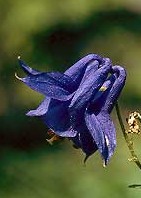 Columbine belongs to the genus Aquilegia that has over 65 species, many of which are good garden plants. The columbine of Shakespeare was probably Aquilegia vulgaris, an excellent garden plant that has blue to violet flowers in spring. The spurs that are so characteristic of all plants in the genus are short, hooked, and end in knobs. The leaves are deeply divided into three rounded lobes. The plant is also called ‘Granny’s Bonnet’ and is one of the classical cottage garden plants in England where it grows up to 1½” tall in rich soil and light to moderate shade.
Columbine belongs to the genus Aquilegia that has over 65 species, many of which are good garden plants. The columbine of Shakespeare was probably Aquilegia vulgaris, an excellent garden plant that has blue to violet flowers in spring. The spurs that are so characteristic of all plants in the genus are short, hooked, and end in knobs. The leaves are deeply divided into three rounded lobes. The plant is also called ‘Granny’s Bonnet’ and is one of the classical cottage garden plants in England where it grows up to 1½” tall in rich soil and light to moderate shade.
Shakespeare refers to columbine in two plays.
1.Love’s Labour’s Lost, act v, sc. 2 (661), as part of the show for the king and princess.
 Armado.
Armado.I am that flower,
 Dumain.
Dumain.
That Mint.
 Longaville.
Longaville.
That Columbine.
2.Hamlet, act iv, sc. 5 (189). Ophelia hands out a series of flowers with symbolical meaning after she learns her father, Polonius, has been killed.
 Ophelia. [speaking to the king]
Ophelia. [speaking to the king]There’s Fennel for you and Columbines.
Columbine was associated with ingratitude, faithlessness, and male infidelity, while fennel suggests that the king had a weakness for flattery also.
Columbine had many meanings and was used in both literature and art. As the popularity of Christianity arose in Europe columbine was associated with Christian virtues such as hope, faith, and charity. The three part leaves were symbols of the Holy Trinity and the spurs of the flowers were seen as five doves sitting together in a circle and referred to the Holy Spirit. The common name was derived from the Latin word columba meaning dove. In religious paintings columbine stood for the Holy Spirit and Jesus.
The genus name, Aquilegia, is generally believed to come from the Latin word aquila meaning eagle and refers to the spurs of the eagle. Another theory suggests that the genus name comes from aquilegus, a water-collector, because of the water-holding powers of the flower. The specific name vulgaris tells us that it is the common form of the genus.